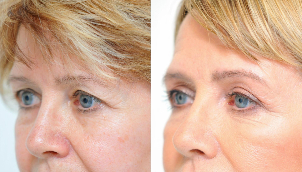
Aesthetic procedures and plastic surgeries that improve the appearance of the eyes are among the most requested. Last year alone, more than 200, 000 women and men underwent eyelid surgery (blepharoplasty) and the number of cosmetic procedures for rejuvenation cannot even be counted.
What is there to know for those who want to improve this part of the face, called by the classic "mirror of the soul"?
Aesthetic problems in the eye area requiring rejuvenation
- Heavy and tired look.
- Fallen eyelids.
- Bags or swelling under the eyes.
- Excessive and wrinkled skin.
Most of these problems can be successfully corrected with upper or lower eyelid lift surgery. Plastic surgery aims to improve the three main components of the eyelid tissue: skin, muscle and fat. The result is beautiful eyes and a youthful appearance.
Rejuvenation of the upper eyelid
Most patients who visit beauty clinics complain of heavy, drooping upper eyelids, which sometimes form a kind of "hood". This condition is called ptosis. Eyelid drooping can be congenital or caused by injury, nervous system disease, and even improper administration of Botox.
Before the operation, the doctor finds out the reasons for droopy eyelids, which allows you to get rid of it most effectively. It is necessary to take into account the condition of the muscles of the eyelid. If they are weak, canthopexy or cantoplasty is performed, which strengthens the muscle structures. It is usually done in conjunction with blepharoplasty.
During the operation, the skin and excess fat, which protrudes from the depths of the tissues, are removed. The technique gives immediate results, improving the contour of the eyelids, making the eyes more open and the face rested and refreshed.
If the soft tissues of the forehead are loose and sagging, an eyebrow lift and forehead correction in addition to eyelid lift is indicated.

How plastic surgery solves lower eyelid problems
The most common complaints in this area of the face are bags under the eyes. The skin of the lower eyelids is extremely sensitive and becomes thinner with age. Wrinkles appear under the eyes, similar to crumpled thin paper, through which fat protrudes.
This condition is corrected with a facelift - lower blepharoplasty. During the operation, the excess skin is removed along with the protruding fat. If necessary, the doctor tightens the stretched muscles.
In patients with a small amount of excess skin, it is compressed (pinched), which makes the contour of the lower eyelid smoother.
With marked age-related changes, it is often necessary to operate on both eyelids to significantly rejuvenate this area.
Non-surgical methods of eyelid rejuvenation
In addition to surgery, there are a growing number of non-surgical procedures aimed at improving the appearance of the eyelid skin:
- Microneedles- a procedure during which the skin is pierced with small needles. As a result, small holes remain on it, which the body tries to repair by producing collagen and elastin proteins.
- Chemical peelingwith various natural compounds that rejuvenates the skin and removes wrinkles.
- Laser treatments, which stimulate metabolic processes and cause muscle contraction.
- Radiofrequency and ultrasound treatmentsthat firm and smooth the skin.
Operative and non-operative methods of eyelid correction should not be considered mutually exclusive. Both techniques can be used together, they organically complement each other and give excellent results.
Correction of nasolacrimal sulci
At the junction of the lower eyelid and cheek, there is a nasolacrimal groove, which becomes more evident with age. The soft tissues of the face lose volume and the force of gravity causes them to stretch downwards. A dark, arched area forms under the eyelid, making the eyes tired and aged.
In the process of improving the aesthetics of this area, the tear duct is filled in several ways:
- With the help of fillers - fillers that replenish the lost tissue volumes.
- By adding fat cells transferred from other areas of the body.
- The condition of this area improved with the help of non-surgical procedures: microneedles, radiofrequency, ultrasound and laser methods.
Injections of platelet-derived plasma (PRP) from the patient are also used. Plasma is rich in growth factors that stimulate rejuvenation of the skin overlying the nasolacrimal sulcus.
A beautician will help you choose a combined method consisting of several procedures that complement each other.
Rejuvenating features of the eye area
Upper and lower eyelid plastic surgery can provide immediate, lasting and noticeable results. But when performing them, it is necessary to take into account one important nuance. Many nerves and blood vessels pass through this area and its tissues are very thin and delicate. Therefore, the operation can only be trusted by a doctor with extensive experience, who has experience in performing blepharoplasty.
When performed correctly by experienced plastic surgeons and cosmetologists, the rejuvenation procedure produces excellent results that satisfy patients.














































































